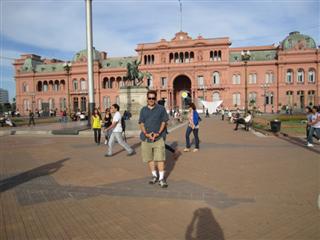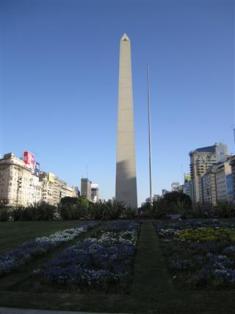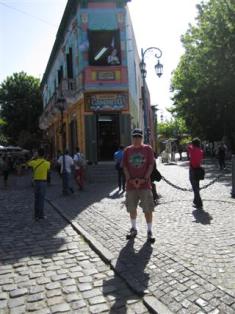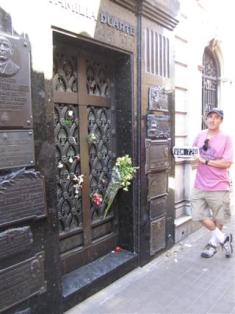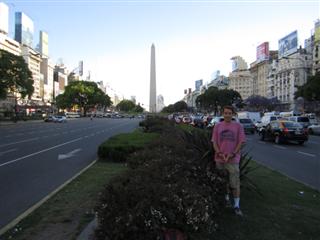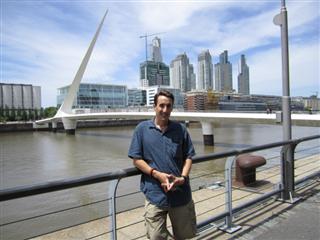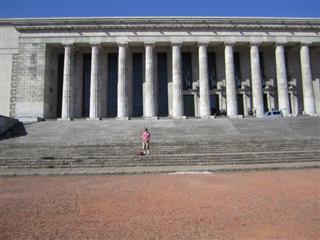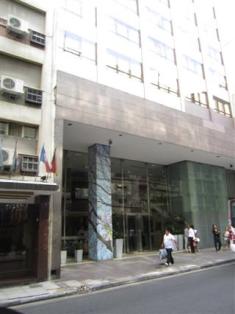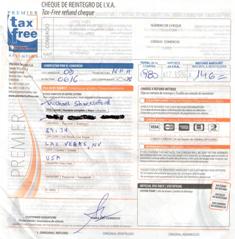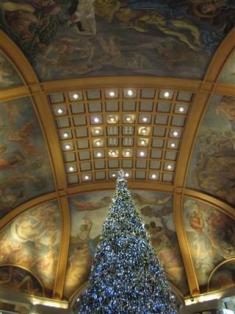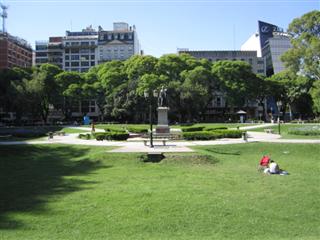Buenos Aires
According to Wikipedia, Buenos Aires population of 13 million makes it the city with the second largest urban population in South America, behind Sao Paulo. It is a crowded and busy city, with everybody walking and talking in a hurry. I spent six days there in November 2011. The following article represents my advice on genearl things to do, and not do.
Note: If all you care about is my casino report on Argentina, that is coming soon in a separate article.
Buenos Aires is a mix of the old and the new and old, southern-European-looking buildings juxtaposed by modern, boxy office buildings and apartments. The layout reminds me of Washington DC, with a logical grid of streets running north to south and east to west. Add in some major streets that run diagonally, Greco-Roman style government buildings, lots of small parks, some roundabouts, and an obelisk, and it is like a large, Latin version of DC.
In terms of the general demeanor of the people, it is more like New York. Everybody walks and talks quickly and with a purpose. While the residents, known as Porteños, are down to business, they still are generally friendly and not too pushy.
I hope it won't offend anybody if I say that the vast majority of Porteños are as white as me, so it is easier for a Gringo like myself to blend in. Nevertheless, Gringo or not, it probably didn't make much difference. I don't think enough Americans make it down to Buenos Aires to cause a bad reputation. Hopefully the following advice will come in handy should you make it there.
Transportation
Airports
Long distance flights are serviced by the Ezeiza airport. I found getting through customs to be very quick and efficient. Americans must pay a $140 entrance fee. This is in retaliation for visa fees the US government imposes on Argentine citizens. The fee is good for travel in and out of Argentina for ten years. Canadian and Australian citizens must also pay an entrance fee; I didn't note how much.
Short distance flights are serviced by the Aeroparque. I used this airport twice for my jaunts to Puerto Iguazu and Punta del Este, Uruguay. Be warned that check in lines at the Aeroparque for AerolÃneas Argentinas are enormous. There is no curbside service to avoid the line.
Tienda Leon
The Ezeiaz airport is far outside the city, so a cab or remis ride (similar to a chauffeured vehicle) would be expensive. As you clear customs, on the left side there will be a business called Tienda Leon (lion store). They have large buses that take passengers to their other bus station in the Microcenter downtown area. The cost is 55 pesos, which comes to about $13. For an additional 10 pesos, you can buy a transfer, which will buy you a ride in a smaller van that delivers you directly to your hotel.
The service is very convenient and worth every penny. They also have private cars at significantly greater expense, about 280 pesos. When you are ready to leave, any decent hotel can probably make arrangements with the Tienda Leon. Be sure to specify if you want the bus or a remis. In my case, I didn't specify, and they sent a remis, which cost me the equivalent of about an extra $60.
Taxis
The official black and yellow taxis are easy to find. You can tell if one is available if the "Libre" light is on. I've been warned there are a lot of hacks (unlicensed cab drivers) who hang out at the airport and should be avoided. I think you can generally tell a hack if they don't use the dedicate taxi queue and the car doesn't have a meter. Don't expect the cab drivers to speak a word of English or advice that applies to any non-English speaking country.
If you are not going to a place the driver is likely to be familiar with, I would suggest instructing the driver of the closest intersection to wherever you want to go. The rates are higher at night, for reasons I don't understand. In my opinion, they should be cheaper because traffic is lighter. Also, the drivers are stingy with the air conditioning.
Remises
I'm not sure on what basis they charge, but expect a remis ride to be more expensive than a taxi. A remis might be appropriate if you have a large group, are going outside the city limits, or just want a nice air-conditioned vehicle.
Subway
Buenos Aires has a subte (subway), although I never had a reason to take it. It generally carries passengers from the downtown area to the residential areas to the west. For bouncing around between tourist attractions, it is unlikely to help.
Walking
Buenos Aires is bustling with pedestrians walking in a hurry. The city is a bit quiet until about noon, but then stays busy until well past midnight. The streets are very dirty and in ill-repair by American standards, but I got the feeling that they were pretty safe.
Money
The government of Argentina pegs the value of its peso to the US dollar. To be specific, one US dollar can be exchanged for about 4.2 pesos at the banks. However, many merchants seem to prefer the dollar and give better than the market rate, up to 4.6 pesos per dollar. I've heard you can also do better on the black market, but you run the risk of getting counterfeit bills. My advice is to bring US currency. When you get to the airport, get some pesos from an ATM. Whenever you can, pay in dollars. You are likely to get pesos back in change, rather than dollars.
You should also be warned that taxi drivers and stores that deal in small transactions tend to not have much change. If they can't make change, don't expect the difference to cut your way. My advice is hoard your coins and small notes. When you buy something at a nice restaurant or store, pay in 100 peso notes, to garner more small notes and coins in change.
If you have some foreign currency, other than US dollars, you should change it only at the Banco Nacion de Argentina. All the other cambio (change) businesses offer much inferior rates. Just to warn you, the lines at the Banco Nacion tend to run rather long, like 15 minutes. At the Ezeiza airport, there is a Banco Nacion office to the right as you exit customs. Personally, I had a lot of Australian dollars I wanted to get rid of. The private cambio joints only offered about 3.1 while the Banco Nacion offered 3.8. Still disappointing, considering the Australian dollar was worth about $1.02 US at the time. There was a more respectable rate for the Euro, but ultimately the good old US dollar is king in Argentina.
In any foreign country I'm big on using credit and debit cards. It is safe, easy, and you'll get a fair exchange rate. However, some places don't accept them, and I think it looks bad to use them for really small purchases.
Finally, most things are expensive in Argentina, especially material things. Don't expect to go on a shopping spree there; Argentines come to the US to do that, because the prices are lower here. Hotels and restaurants charge about what you would pay in a large city in the US. The only thing that is a little cheaper are services, like haircuts and massages.
To summarize, my advice is use credit or debit cards for big purchases, US cash for medium ones, and pesos for small ones.
Things to Do
Casa Rosada
The Casa Rosada is Argentina's version of the white house. Actually, president Christina Kirchner lives in a well-protected mansion elsewhere in the city, but she still does the nation's work in what would be translated into English as the Pink House.
I hate to say this, but the shade of the so-called pink is rather ugly. It is speculated that the original paint job used cow blood to dye white paint red, and based on the appearance, I believe it.
In a park just outside the Casa Rosada, as well as on the fence to the Casa itself, are lots of left-wing political statements that look like they were written on bed sheets with spray paint. Perhaps this is where Ron Paul supporters got the idea.
On the topic of political statements, I noticed a plaque about a message to the youth from former leader Juan Peron. He evidently had it buried there, to be opened in the year 2000. I don't know when it was buried, but Peron died in 1974, so it must have been there at least 25 years. Later I did a little research, hoping to be inspired by some words of wisdom so profound that they needed 25 years to simmer. It turned out to be an anti-capitalist rant, the kind which he probably gave many times before. Perhaps a speech he never got around to giving, so he had it stuffed into a time capsule.
Obelisk
The Obelisk of Buenos Aires looks pretty much just like the Washington Monument in DC. Here are some facts about both of them:
Obelisk Comparison
| Metric | Washington DC | Buenos Aires |
|---|---|---|
| Height | 555 feet | 221 feet |
| Started | 1848 | March 20, 1936 |
| Completed | 1884 | May 23, 1936 |
So, ours is bigger and older. However, in terms of time to completion, they beat us in a blowout. Argentina built their obelisk in 64 days while it took us 36 years.
Tango Show
From everything I've been told, going to Buenos Aires for the first time and not seeing a tango show would be like going to Vegas without seeing at least one show of some kind. It seemed like a fun idea, so I chose to attend the one at the Cafe de los Angelitos (cafe of the little angels). There were lots to choose from, but this one had the best web site, which won me over. The prices were $90 for the show only or $130 for a show/dinner combination. Patrons who pay for the dinner are seated on the main floor, while the rest are banished to the balcony.
Unlike the picture on the web site, the seating was community style, with very long tables, like in the wedding party scene in the movie Hair, or at the Haufbrau Haus in Las Vegas. Fortunately, my friend and I were seated next to a friendly couple from Vancouver. The dinner was nothing short of outstanding. Among the most memorable meals I have ever had. It is worth much more than the extra $40. The menu offers the choice of three appetizers, entrees, and dessert. It also includes the all the beverages you can drink, including wine.
The show featured lots of singing, music, and, of course, tango dancing. The stage performers included five couples, two singers, and a five-piece orchestra. Some musical numbers had all five couples dancing, and some featured just one. A few featured one of the vocalists. There was a costume change between each number. I am no expert at this topic, but it seemed to me like also a fashion history of the early 20th century.
Here is a bit of trivia I learned during this trip. Before the tango attained its recent popularity, it was only found in the brothels of Buenos Aires. I guess the dancing served as an ice breaker. Good idea.
I'm easily pleased when it comes to watching others dance. My dancing ability falls right about where you would expect for a math geek, so I'm very envious of those who can do it well. From this amateur's eye, everything looked very well choreographed and the dancing seemed perfect. I enjoyed everything about it and would highly recommend this show to anyone.
Caminito
Caminito, meaning little road, is a small section of Buenos Aires with two-story buildings painted in bright colors. Any guide of tourist attractions in Buenos Aires is sure to have it near the top of the list, and it is often seen in montage postcards of Buenos Aires.
Let me tell you, the Caminito is a tourist trap! It is mostly souvenir stores selling the same trinkets you find everywhere else tourists tend to congregate. Immediately surrounding this little area is what looks like a slum. My travel book suggested not going here at night, and I can see why. In fact, don't go during the day either; it is a waste of time.
Museums
The two museums I visited were both free with no pressure for a donation. I'm told that the other museums in the city are also free or nearly free.
Museo Nacional de Bellas Artes
Classic art lovers I'm sure will leave happy. This museum features works by such big names as Renoir, Monet, Gaugin, Cézanne, and Picasso (I got this from my travel book). There are also plenty of paintings by Argentine artists I haven't heard of but look just as impressive as the European works. When I was there, the second floor was unfortunately mostly closed. I would allow about 60 minutes for the first floor, depending on your interest. It is located in the Recoleta neighborhood.
Museo de Arte Moderno
This museum features mostly paintings, most of which look like the handiwork of a four-year-old. Definitely more down to earth than American modern art. To be honest, I can't say this museum impressed me very much. It is located in the San Telmo neighborhood. I find there isn't a whole lot to do in that area. The museum is an easy walk from the central square.
Recoleta Cemetery
I would recommend putting this famous cemetery high on your list of things to do. It is the home of hundreds of crypts of famous Argentines. When the rich and famous die in Buenos Aires, they go out in style. Some are small and in ill-repair while others are huge and well maintained. Here you'll find many former presidents and other big names in Argentine history. However, the big celebrity of the Recoleta Cemetary is Evita. She shares it a crypt with various other members of the Duarte family (her maiden name). It is about average in size, but there is no shortage of visitors coming to take a photo of it.
Streets
Calle Florida (Florida Avenue)
This is a bustling pedestrian street spanning several blocks in the Microcenter part of town. It is surrounded by small stores of all types, some touristy and others selling the whole gamut of stuff. Argentina is famous for leather, so expect to see a lot of stores selling leather clothing and shoes. If you don't like crowds, go in the morning, if you do, go in the late afternoon.
Avenida 9 de Julio (July 9 Avenue)
The Avenida 9 de Julio is known as the widest avenue in the world. It also is home to the Obelisk, which easily fits in the middle. There are six lanes of traffic in each direction, with three long islands separating the two directions of traffic from each other, as well as from the two other two-lane avenues bordering the sidewalks. The entire thing consumes an entire city block in width. Due to the way the lights are synchronized, it takes pedestrians quite a while to cross it, requiring waiting at 2 or 3 red lights.
Reconquista (Recapture)
I'm not sure if this is supposed to be an avenida, calle, or camino, but it is pretty much a pedestrian street. It is located two blocks to the east of Avenida Florida. Here you will find lots of bars and small restaurants, most of which with outdoor seating. Men without the pleasure of female companionship will probably be approached by prostitutes or doormen trying to facilitate such introductions. One such doorman opened a nondescript, closed door in front of me, revealing several working girls inside with broad, flirty smiles.
Neighborhoods
Puerto Madero
This is a new part of town on the east side of Buenos Aires. The city evidently rezoned what was previously undeveloped land and built what seems to be mostly high-end apartments. It is a quiet and clean area, but it lacks the energy of the rest of the city.
The only part worth visiting, in my opinion, is the dike separating Puerto Madero from the downtown Microcenter. Along both sides of the dike are wide walking paths, fronted by many nice restaurants. It is similar to the Inner Harbor of Baltimore, but less touristy. This would be a perfect spot to do some jogging.
San Telmo
This is known as the tango section of the Buenos Aires. At the center of it is the Plaza Durango, which features outdoor restaurant seating and intermittent tango dancing for entertainment. The dancers walk around with a hat for tips after they finish. The dancing was nowhere as impressive as the tango show I wrote about above, so don't let the free outdoor tango entertainment stop you from enjoying a full-blown show.
As is generally the case with inexpensive cafes in Argentina, I was not very impressed with the food or the service. Surrounding the plaza are lots of nice antique shops. This is where I managed to find some Argentina license plates, which are not otherwise easy to find for sale.
Recoleta
I highly recommend a visit to this neighborhood. Here you will find fewer tourists and more real Porteños eating, drinking, shopping, and strolling. Before I found this neighborhood, my impression of Buenos Aires, based on the Microcenter and Puerto Madero, was that I was living in the movie Children of Men, in which nobody was under the age of 40. However, I think all the young are hiding out in the Recota neighborhood. There is also plenty to do, with lots of museums, parks, and the cemetery, which I wrote about above.
Architecture
Lots of government buildings are in the same Roman style you see in Washington DC. The picture to the right is of a law school in the Recoleta area. Otherwise, the city has lots of French architecture. According to this Natalie Tran video, after Argentina's independence from Spain they wanted to emulate anyplace but Spain, but mostly with the Parisian look.
Food
If there is just one word you need to know about food in Buenos Aires it is carne, which you probably know is Spanish for beef. (Note: After publishing this, a Spanish reader corrected me saying that carne means meat in general, although amateurs like me frequently use it to mean the meat of a cow. If you want to be accurate, I'm told the correct term for beef is carne de vaca.) I don't know what causes it to taste so good, but the beef there has a different taste and texture to it. And it is irresistible. It is more tender and has a sharper bite to it than American meat, on average. American beef has more of a fatty taste, while Argentine meat is more lean. I've heard the Argentine beef tastes so good because of the wild pampas grass the cattle eat.
For a quick snack, Argentines love alfajors. These are individually wrapped snacks, consisting of two cookies, with caramel in the middle and enrobed in chocolate. Not terribly unlike a Twix candy bar, but alfajors are better. If you want something cooler, ice cream parlors (heladerÃas) are both ever-present and good.
For casual eating, Argentines seem to like the same stuff we do. The menu of the average cafe will have sandwiches, pizza, hamburgers, hot dogs (ponchos), and ravioli. Quality will vary. I would suggest avoiding sandwiches in Argentina, as they don't measure up to ours.
One nice tradition in Argentina is hotels generally serve a free continental breakfast.
Hotels
Hotels in Buenos Aires are not cheap. I can only speak to the two hotels I stayed at.
Dazzler Suites on San Martin
There are four Dazzler hotels in Buenos Aires. The one I stayed at was well located on San Martin Street, which is between Florida and Reconquista, which I wrote about above. In that area, there are lots of medium-sized hotels. The Dazzler was more than adequate for comfortable living but nothing extravagant. The furniture was very modern, but the carpeting in my room was covered in stains.
Emperador
The other hotel I stayed at was the very elegant Emperador. It is located at the north end of the famed July 9 Avenue (Avenida 9 de Julio), within easy walking distance of the high-end Patio Bullrich shopping center, and just several blocks from the historic Recoleta neighborhood. Somehow I got a good price on this hotel online, not much more than what I paid for the Dazzler, but the quality was significantly better. If you get homesick, be prepared to hear more English and American amongst the guests, by a wide margin. The entire interior and garden in the back will make you think you were transported to a fancy hotel in Philadelphia or Boston. Also be prepared for the American-style shakedown for Internet access. Of the four hotels I visited in South America, this was the only one without free wi-fi for hotel guests.
Shopping
I would take it easy on the shopping if you are coming from the US, as prices are generally higher in Argentina. One exception might be leather, as Argentina is famous for it.
Sales taxes are 21% in Argentina (ouch!), and are hidden in the cost of the item. In other words, a Value Added Tax (VAT). To ease the pain for foreigners, some stores participate in a "tax free shopping" program. Your odds are better at high-end stores, which should display a "tax free shopping" sign. Why most stores choose to not participate in this program, I don't know.
Following are the steps to go through to get your sales tax back from "tax free shopping" stores.
- Ask for the tax refund form at the store. An image of mine is to the right.
- At the airport, present said forms and the purchased items at the designated window. Here they will stamp the receipts.
- Check in to your flight.
- After going through initial passport control, there will be a line for presenting said receipts to get your money back.
Here is the image of the form. I still have it because I didn't know I needed to present the items and foolishly reversed steps 2 and 3 above, making me ineligible.
Pacifica Galleria
The Pacifica Galleria a classic older building that used to be an art museum. It still has the murals on the ceiling. This mall has three levels and is pretty upscale. I got a haircut there, which I was happy with. It is conveniently located off Florida Avenue.
Patio Bullrich
The Patio Bullrich is even more upscale than the Pacific Galleria. Lots of designer names and fancy clothes. It is located at the intersection of Libertad and Libertador (Liberty and Liberator). I think this is because this is where to go to liberate your money from your wallet.
Telephone/Internet Access
Lots of convenience stores have computers in the back with Internet access. The prices are low, 10 pesos an hour at most. In addition, they offer little phone booths (cabinas telefonicas) where you can make cheap calls to anywhere in the world. Stores generally indicate the availability of such services with a picture of a computer and/or telephone receiver.
Language
Be warned there are some differences between Mexican Spanish, the form Americans generally know, and Argentine Spanish. Here are some examples:
- The "ll" combination, which makes a "y" sound in Mexican Spanish, makes an "sh" sound in Argentina.
- Instead of tú they say vos.
- Instead of Espanol they say Castallano.
- They often omit the i in verbs for the present tense. For example, instead of tiene they would say tene.
Tipping
From what I experienced and read, the only situation where a propina (tip) is expected is in restaurants. The standard tip is 10%. When I went to the tango show, the tip was already included in the bill, and it doesn't hurt to always check for that. Said advice applies to everywhere, including the US.
With cab drivers, passengers generally round up to the nearest 5 pesos. For other situations, I don't really know, but I think you're fine without tipping. I never tipped the doormen at my hotel, and I didn't get the cold shoulder for it as I did in Panama.
To summarize, here are my pros and cons of Buenos Aires:
Pros
- Vibrant and energetic. Comparisons to New York City would be easy to make.
- Outstanding meat.
- Traffic is not that bad. I think car ownership is very uncommon, so congestion is not a major problem.
- I don't have any statistics to prove it, but I got the impression the city is pretty safe.
- Plenty of things to do.
- If you're a pale-faced tourist like me, you'll blend in easily for a Latin American country.
- Beautiful women.
Cons
- Expensive
- Streets are dirty and the sidewalks are narrow.
- Difficult to meet people (other than prostitutes along the Reconquista) if you're by yourself.
Miscellaneous Pictures
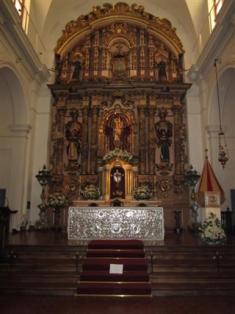
Church near the Recoleta Cemetary.
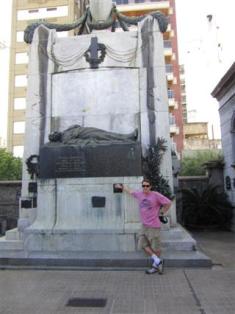
Crypt of Manuel Pedro Quintana, president of Argentina, 1904-1906.
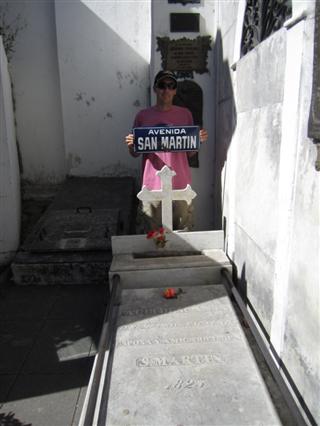
Crypt of Jose de San MartÃn (1778-1850), former general of Argentina. General San Martin gets most of the credit for winning the war of independence from Spain. There are things named after him all over Buenos Aires. I'm holding an old street sign from Avenida San Martin, that I just happened to be lugging around when I went to the cemetery.
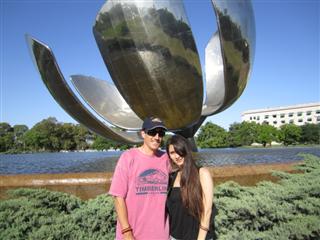
My lovely guide Sophia and I at the Parque Carlos Thays. That is an enormous metal flower behind us.
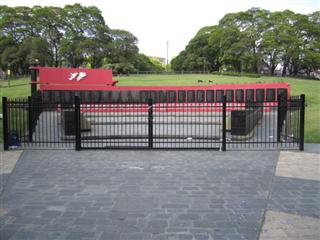
Lots of memorials to the Falkland Islands, or the Islas Malvinas as they call them, which Argentina still claim.
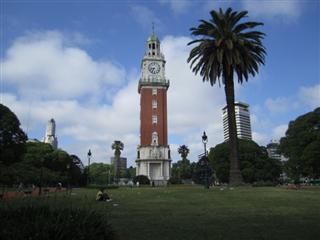
Clock tower at the Plaza San Martin.
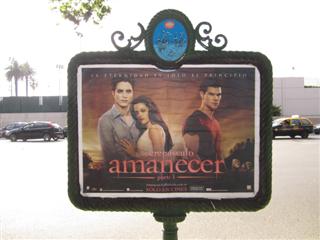
If there is one word I added to my Spanish vocabulary this trip it is amanecer, which means sunrise, or in the case of the movie "Breaking Dawn." There were posters for the movie all over the city.
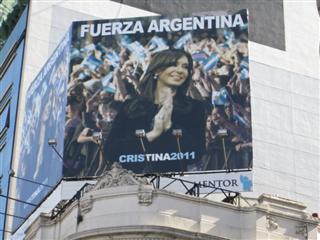
Coming in second behind Bella, Edward, and Jacob, there are lots of signs for current president of Argentina, Christina Kurchner. This billboard was quite big, on the top of a building. Lots of graffiti about her too, mostly favorable.
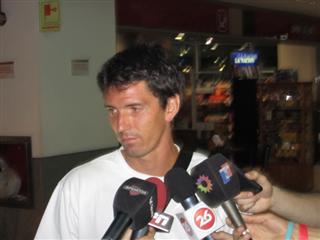
I saw this handsome fellow in the Ezeiza airport on my out, surrounded by television cameras. After publishing this my readers tell me that he is likely tennis player Juan Ignacio Chela.
Other Pages from the Wizard's Argentina Trip
- Casino report on Argentina and Uruguay by the Wizard.
- Puerto Iguazu by the Wizard.
- Iguazu Grand Casino by Aluisio.



